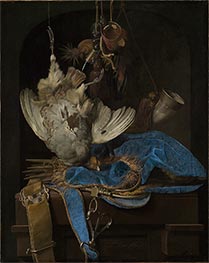Still Life Painting Reproductions - Page 55
Still life painting is a genre of art that depicts inanimate objects, such as flowers, fruits, vases, books, and other household items, arranged in a composition. The genre has a long history dating back to ancient civilizations, with examples found in Egyptian tomb paintings and Greek and Roman vase paintings. During the Renaissance, still life paintings gained popularity in the Netherlands and later spread to other parts of Europe. The genre was used to make symbolic and moralistic statements, as well as to show off the wealth and taste of the patrons. In the 19th and 20th centuries, still life paintings became an important genre in the development of modern art, with the artists experimenting with form, color, and texture. Today, still life painting continues to be a popular genre, with artists exploring new interpretations and styles.
During the Dutch Golden Age, still life paintings became highly valued, as they often incorporated elements of luxury and prosperity, such as fine silver and glassware, exotic fruits, and beautiful flowers. Artists like Jan van Huysum and Rachel Ruysch were known for their skill in painting highly detailed and lifelike still life compositions.
In the 19th century, the still life genre evolved again with the advent of Impressionism. Artists like Édouard Manet and Pierre-Auguste Renoir incorporated new techniques and styles, using loose brushwork and vibrant colors to capture the fleeting effects of light and color.
The still life genre has also been influenced by movements such as Cubism and Surrealism, with artists like Georges Braque and Salvador Dalí using the form to explore abstract concepts and dreamlike imagery.
Today, still life remains a popular genre, with contemporary artists continuing to push the boundaries of what is possible within the form. From photorealistic paintings to abstract compositions, the still life genre continues to evolve and inspire new generations of artists.
During the Dutch Golden Age, still life paintings became highly valued, as they often incorporated elements of luxury and prosperity, such as fine silver and glassware, exotic fruits, and beautiful flowers. Artists like Jan van Huysum and Rachel Ruysch were known for their skill in painting highly detailed and lifelike still life compositions.
In the 19th century, the still life genre evolved again with the advent of Impressionism. Artists like Édouard Manet and Pierre-Auguste Renoir incorporated new techniques and styles, using loose brushwork and vibrant colors to capture the fleeting effects of light and color.
The still life genre has also been influenced by movements such as Cubism and Surrealism, with artists like Georges Braque and Salvador Dalí using the form to explore abstract concepts and dreamlike imagery.
Today, still life remains a popular genre, with contemporary artists continuing to push the boundaries of what is possible within the form. From photorealistic paintings to abstract compositions, the still life genre continues to evolve and inspire new generations of artists.
page 55 of 55
Still Life of Dead Birds and Hunting Weapons 1660
Willem van Aelst
Oil Painting
$3194
$3194
Canvas Print
$59.26
$59.26
SKU: AWV-3
Willem van Aelst
Original Size: 86.5 x 68 cm
Gemaldegalerie Berlin Germany
Willem van Aelst
Original Size: 86.5 x 68 cm
Gemaldegalerie Berlin Germany
Still Life with Hunting Equipment and Dead Birds 1668
Willem van Aelst
Oil Painting
$2618
$2618
Canvas Print
$59.40
$59.40
SKU: AWV-1
Willem van Aelst
Original Size: 68 x 54 cm
Staatliche Kunsthalle Karlsruhe Germany
Willem van Aelst
Original Size: 68 x 54 cm
Staatliche Kunsthalle Karlsruhe Germany

